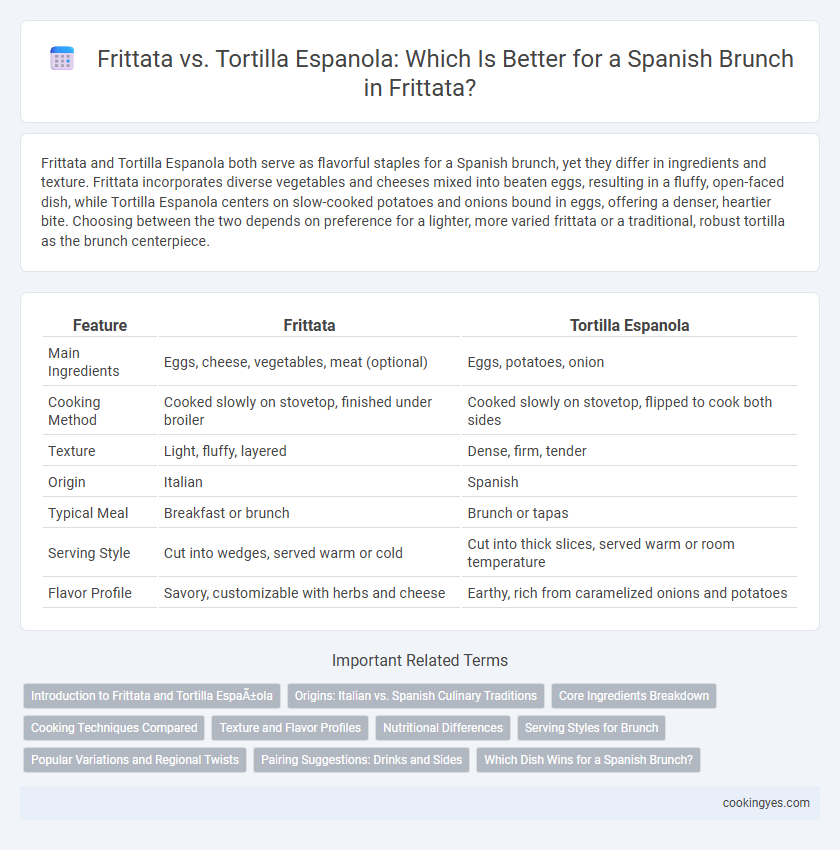Frittata and Tortilla Espanola both serve as flavorful staples for a Spanish brunch, yet they differ in ingredients and texture. Frittata incorporates diverse vegetables and cheeses mixed into beaten eggs, resulting in a fluffy, open-faced dish, while Tortilla Espanola centers on slow-cooked potatoes and onions bound in eggs, offering a denser, heartier bite. Choosing between the two depends on preference for a lighter, more varied frittata or a traditional, robust tortilla as the brunch centerpiece.
Table of Comparison
| Feature | Frittata | Tortilla Espanola |
|---|---|---|
| Main Ingredients | Eggs, cheese, vegetables, meat (optional) | Eggs, potatoes, onion |
| Cooking Method | Cooked slowly on stovetop, finished under broiler | Cooked slowly on stovetop, flipped to cook both sides |
| Texture | Light, fluffy, layered | Dense, firm, tender |
| Origin | Italian | Spanish |
| Typical Meal | Breakfast or brunch | Brunch or tapas |
| Serving Style | Cut into wedges, served warm or cold | Cut into thick slices, served warm or room temperature |
| Flavor Profile | Savory, customizable with herbs and cheese | Earthy, rich from caramelized onions and potatoes |
Introduction to Frittata and Tortilla Española
Frittata is an Italian egg-based dish enriched with vegetables, cheese, and meats, offering a versatile and open-faced approach to brunch. Tortilla Espanola, also known as Spanish omelette, features a thick, hearty combination of eggs, potatoes, and onions cooked slowly for a tender and savory texture. Both dishes highlight regional ingredients and cooking techniques that define Mediterranean brunch traditions with unique flavor profiles.
Origins: Italian vs. Spanish Culinary Traditions
Frittata, rooted in Italian culinary traditions, features beaten eggs combined with diverse ingredients like vegetables, cheeses, and meats, cooked slowly to create a fluffy, versatile dish. Tortilla Espanola originates from Spanish cuisine and is characterized by a thick, hearty omelette primarily made with eggs, potatoes, and onions, reflecting Spain's rustic flavors. Both dishes showcase their respective cultures' approaches to egg-based meals, with the frittata emphasizing a more varied ingredient mix and the tortilla espanola highlighting simplicity and regional staples.
Core Ingredients Breakdown
Frittata and Tortilla Espanola both feature eggs as the base but differ significantly in their core ingredients, making them distinct for a Spanish brunch. Frittata typically incorporates a variety of vegetables, cheeses, and meats like spinach, mozzarella, and ham, offering a versatile flavor profile. Tortilla Espanola, on the other hand, centers on potatoes and onions, creating a dense, hearty dish with a simple yet rich taste that defines traditional Spanish cuisine.
Cooking Techniques Compared
Frittata uses a gentle stovetop-to-oven cooking method, allowing eggs to set slowly while ingredients like vegetables and cheese meld evenly, resulting in a creamy texture. Tortilla Espanola is traditionally cooked entirely on the stovetop with slower, careful flipping to achieve a dense, firm consistency, emphasizing the caramelized flavors of potatoes and onions. Both techniques highlight different textures and flavors, with the frittata's lightness contrasting the tortilla's hearty, rustic appeal.
Texture and Flavor Profiles
Frittata features a light, fluffy texture with a creamy interior, contrasting the dense, firm texture of Tortilla Espanola made from slow-cooked potatoes and onions. Flavor profiles differ as frittata offers versatile seasoning with fresh herbs and cheeses, while Tortilla Espanola delivers a rich, earthy taste from caramelized onions and the natural sweetness of potatoes. Both dishes represent quintessential Spanish brunch options but cater to distinct preferences in mouthfeel and ingredient complexity.
Nutritional Differences
Frittata and Tortilla Espanola differ significantly in nutritional content, with frittatas typically containing more protein and fewer carbohydrates due to their inclusion of diverse vegetables and cheese. Tortilla Espanola, made primarily from potatoes and eggs, is higher in carbohydrates and often contains more calories and fat from fried potatoes. Choosing between the two for a Spanish brunch depends on dietary goals, with the frittata offering a protein-rich option and the tortilla providing a more energy-dense, traditional Spanish flavor.
Serving Styles for Brunch
Frittata and Tortilla Espanola differ significantly in their serving styles for Spanish brunch, with frittata typically served in larger wedges, allowing easy sharing and customization with various toppings. Tortilla Espanola, a thick potato and onion omelet, is commonly sliced into smaller, bite-sized pieces ideal for tapas or communal dining. Both dishes emphasize versatility, but the frittata's open-faced presentation suits personal plates, while the tortilla's rustic slices encourage social, casual brunch settings.
Popular Variations and Regional Twists
Frittata and Tortilla Espanola both showcase regional twists that highlight local ingredients and cooking techniques in Spanish brunch culture. Popular frittata variations often incorporate Mediterranean vegetables, cheeses, and herbs for a fluffy, oven-baked texture, while Tortilla Espanola emphasizes thick layers of potatoes and onions slowly cooked in olive oil for a dense, hearty flavor. Each dish reflects unique culinary traditions, with frittatas adapting to global influences and Tortilla Espanola maintaining its classic Castilian roots through simple yet rich combinations.
Pairing Suggestions: Drinks and Sides
Frittata pairs well with light, refreshing drinks such as a crisp white wine like Albarino or a sparkling Cava, enhancing its rich egg and vegetable flavors. Tortilla Espanola complements robust reds like Tempranillo or a chilled glass of sherry, balancing the hearty potato and onion elements. Serve frittata alongside mixed green salads or roasted vegetables, while tortilla pairs best with marinated olives, crusty bread, and Manchego cheese for an authentic Spanish brunch experience.
Which Dish Wins for a Spanish Brunch?
Choosing between frittata and Tortilla Espanola for a Spanish brunch depends on the desired flavor and texture profile; Tortilla Espanola, made with potatoes, onions, and eggs, offers a hearty, traditional taste deeply rooted in Spanish cuisine. The frittata, often incorporating a wider range of vegetables and cheeses, provides a lighter, more versatile option suited for contemporary palates. For an authentic Spanish brunch experience, Tortilla Espanola wins due to its rich cultural significance and satisfying, dense consistency.
Frittata vs Tortilla Española for Spanish brunch Infographic

 cookingyes.com
cookingyes.com